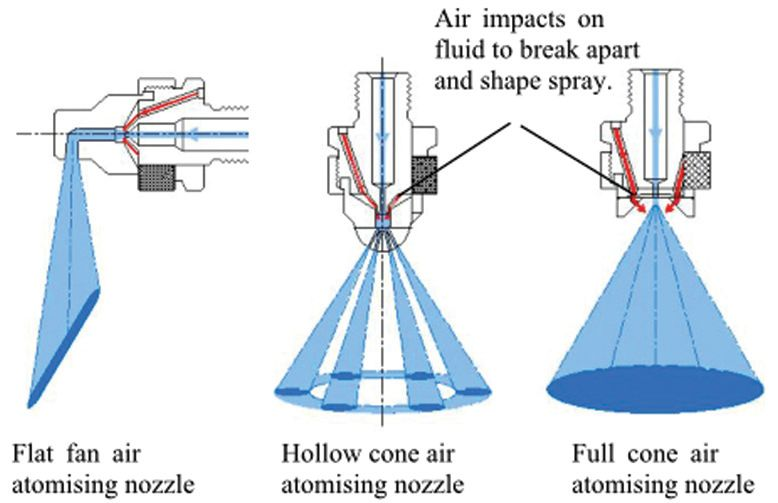 All vessels have to be cleaned efficiently, and while the spray nozzle business may often be described as ‘just flinging about water’, there are numerous ways in which water can be flung! Ivan Zytynski, from BETE, discusses how to go about specifying the correct nozzle to achieve the desired spray
All vessels have to be cleaned efficiently, and while the spray nozzle business may often be described as ‘just flinging about water’, there are numerous ways in which water can be flung! Ivan Zytynski, from BETE, discusses how to go about specifying the correct nozzle to achieve the desired spray
This article explores some of the basic characteristics of sprays and how nozzle selection affects them. This is not an extensive guide to spray dynamics, but a good starting point, giving you an overview of the factors that should be considered.
 There are four basic spray patterns that water can be “flung” in:
There are four basic spray patterns that water can be “flung” in:
1. Flat fan – The liquid is shaped into a fan shaped sheet of fluid. This can be comprised of droplets or a coherent sheet of water. Flat fans can have a spray angle of between 15 and 145° depending on the nozzle design.
2. Hollow cone – The liquid is broken into droplets that are heavily concentrated at the edges of the cone of spray produced. This cone can vary from 30 to 170° in spray angle depending on the nozzle design.
3. Full cone – The liquid is broken into droplets that are more or less evenly concentrated in the cone of spray produced. Again this cone can vary from 30 to 170° depending on nozzle design.
4. Solid stream – A simple jet of focused fluid that has no true droplets. A solid stream will be formed by forcing the fluid through a shaped orifice that focuses the spray into a jet.
One further pattern, which is not a true pattern per se, should be also be included in any discussion of sprays.
5. Misting/fog – This is a homogeneous fog or mist with little or no impact. The pattern starts out as a full or hollow cone but at a short distance from the nozzle orifice the pattern will loose coherence and form a fog or mist.
The basic spray pattern types above, with the exception of misting, allow for simple trigonometry to calculate the area being sprayed. This, along with data on the flow rates at given pressures, constitutes the starting point of spraying system design.
Characteristics of spray
The next step is to examine the consistency and nature of the spray – there are four critical characteristics.
1. Droplet size – The mean droplet size is actually a measure of the overall surface area of the fluid being sprayed. The smaller the droplet size the greater the surface area of the spray for any given volume of fluid. The surface area of a spray is a reasonable approximation to its overall reactivity (its ability to produce a chemical reaction or the spray’s ability to absorb or dissipate heat). Droplet size can also be important when considering the overall entrainment of a fluid within a gas flow.
The size of the droplet is affected by pressure, spray pattern type, spray angle, nozzle type and fluid type.
2. Impact and reach. For some applications it is important that the spray has sufficient reach to ensure it hits its target or is sufficiently well distributed. If spraying into any kind of gas flow or in windy conditions the overall momentum of the spray will be important to know as spray drift can result in the target being missed, contamination of other areas or reduced effectiveness.
Impact is affected by pressures, flow rate and spray pattern type.
3. Actual patterns vs theoretical pattern. Often only a specific area will need to be targeted with a spray and so the overall pattern needs to be calculated. The theoretical spray pattern calculated by basic trigonometry will often be different from what happens in reality, as other factors such as the effects of wind and gas flow, the effects of gravity, fluid viscosity and specific gravity and pressure need to be considered.
4. Liquid distribution. The overall area pattern produced is generally not completely uniform. Some nozzles produce more even patterns than others so, for example, not all full cone patterns of 1 meter diameter will have the same liquid distribution even if the overall flow rate is identical.
Some applications necessitate even spray patterns, while others may actually require deliberately uneven patterns of distribution. Liquid distribution is essentially all down to the design of the nozzle, and hydraulic nozzle options include spiral nozzles, tangential whirl nozzles, and flat fan nozzles. It is worth remembering that the narrower the spray angle the more evenly distributed the liquid will be.
Air atomising nozzles
The discussion so far has been about hydraulic nozzles, which rely on the internal energy of the fluid being sprayed to break it apart into droplets and form the spray pattern. Air atomising nozzles impact compressed air onto the fluid to break it apart and form the pattern. The introduction of a secondary source of energy into the system completely changes the rules outlined previously. Droplet size, impact and reach and liquid distribution are all affected (see diagram left).
Water can, it seems, can be “flung” in a variety of different ways. This article aims to help you specify the correct nozzle to produce the correct spray for your application. It is an extract from a longer article which can be found at www.connectingindustry.com (enter BETE into the search box). This feature will not enable the reader to make a completely informed decision about nozzle selection, but it will provide the starting point for a meaningful conversation with a specialist manufacturer.
BETE

